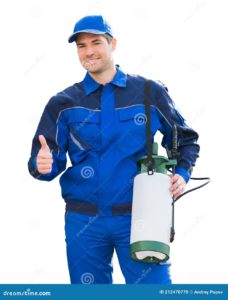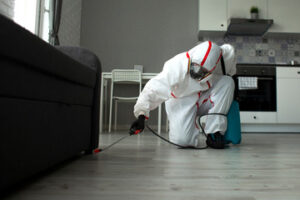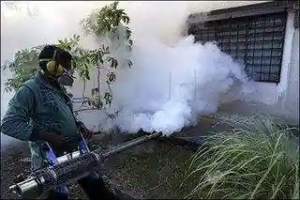An exterminator is a person who eliminates pests such as insects, rodents, birds, and other creatures that cause damage or pose a health risk. Their job involves thorough inspections and treatment plans that are tailored to each infestation.
Whether it is an ant crawling across the kitchen counter or a mouse scurrying around the office, pests can disrupt our daily lives. Thankfully, experienced exterminators are here to help. Contact Exterminator Sherman Oaks now!

A career in pest control is an excellent choice for anyone who enjoys solving problems and helping people. These professionals protect public health, the food supply chain and people’s property by eliminating rodents, insects and weeds in residential and commercial settings. The industry is largely recession-proof and always looking for candidates to fill positions and grow with the company.
Work environments for exterminators vary depending on the type of pest they deal with and the setting in which they operate. In residential settings, they interact directly with homeowners to help them address pest problems. They may have to navigate tight spaces such as crawl spaces, attics or basements in order to inspect and apply treatments. In commercial settings, they collaborate with property managers and other business staff to determine long-term pest management strategies.
When working outdoors, exterminators manage pest infestations in yards, parks, golf courses and other recreational areas. They use specialized equipment and techniques to eliminate pests while minimizing impact on the surrounding environment. Exterminators also work in agricultural settings where they collaborate with farmers and other agricultural professionals to minimize pest impacts on crops and other food products.
As part of their job duties, exterminators must stay up to date on the latest pest control methods and products. They must also follow all safety protocols and regulations when handling chemicals or using pesticides to ensure the health and wellbeing of their colleagues and customers. In addition, they must document their inspections and treatment plans for future reference.
Exterminators typically earn between $22,000 and $50,000 per year, depending on the location of their workplace, the number of clients they service and their level of experience. Many of these professionals have benefits including medical insurance, a 401k plan and paid vacation days. They also receive on-the-job training and the equipment they need to perform their tasks. According to CareerExplorer, exterminators rate their overall job satisfaction at 2.5 out of 5 stars. They are satisfied with their salary but dissatisfied with how well their skills are utilized in the job. See if you’re a good fit for this career by taking our free career test!
Methods of Treatment
An exterminator must be able to fully assess pest infestations and determine the most appropriate method of treatment. This is particularly important when it comes to the use of chemicals, as it’s essential to only apply them when absolutely necessary and in the safest way possible.
In many cases, an exterminator will use a combination of treatments to eradicate the pests and prevent them from returning. For example, if a customer suspects a bed bug infestation, the exterminator may opt to carry out heat treatment and chemical treatments, using the latter in conjunction with Integrated Pest Management (IPM). This holistic approach involves inspection, identification, monitoring, trapping, and educational tactics for long-term control of pest populations.
Chemical treatments can include the direct application of pesticides, especially contact insecticides that kill on contact and residual insecticides that remain effective for longer periods of time. Some types of chemicals also act as repellents, using scents that discourage certain pest species from coming near the property.
Some exterminators also employ mechanical methods to eliminate pests. For example, a cockroach exterminator might spread boric acid around the house, as roaches are compelled to lick it off their bodies as they groom themselves. The acid dissolves in their stomachs, eventually killing them.
Other exterminators work in outdoor environments, managing pest infestations in agricultural settings. This often involves collaborating with farmers to protect crops and ensure food safety. This work requires a great deal of attention to detail as well as specialized knowledge and equipment for managing pests in a wide variety of ecosystems.
While there are many benefits to hiring an exterminator, it’s important for the public to understand the limitations of these professionals. When people call an exterminator, it’s usually because they have a major pest problem that needs to be dealt with immediately. Unusual smells, droppings, bites and property damage are all strong indicators of a pest infestation.
Once the exterminator arrives on the scene, their role is to provide a quick and effective solution. To do so, they’ll need to prepare the area by removing clutter and securing food. They’ll also be responsible for cleaning contaminated areas and maintaining accurate records of the treatments they perform.
Safety Measures
Many chemicals used in the pest control industry can be toxic and cause damage to humans, animals, and the environment if not handled properly. The best way to avoid this is by taking preventive measures before and after the extermination process. These steps should include good housekeeping, cleaning up spills and other waste products, and closing cracks and holes where insects can enter the building. Some chemicals can also be flammable or explosive and should therefore be stored carefully in designated areas.
Another important step is conducting a risk assessment to identify fire and explosion hazards. This can be done through a number of methods, including assessing the layout of the workplace and materials used. It is also a good idea to review the use of equipment, such as generators and power tools, and to ensure that it is operating correctly. Finally, it is advisable to use personal protective equipment (PPE) when handling potentially hazardous chemicals.
Before commencing any pest control activity, it is important to read the product label and manual of instruction thoroughly. This will include safety precautions, warning symbols, and age/experience/skill related qualifications. It is also a good idea to consult with other employees and workers who may have knowledge of the specific hazards involved in the work.
It is also important to consider the type of chemicals that will be used in the work. For example, chemicals meant for outdoor pest management may be more toxic indoors due to their properties and ingredients. In addition, some pesticides are designed with specific chemical compositions that are less effective indoors.
Lastly, it is important to make sure that all work areas are cleaned thoroughly after each pest control operation. This will remove any residual chemicals and ensure that the area is safe for re entry by workers and other people.
It is important to wait until the pest control company tells you it is safe to re enter your home. It is unsafe to do so before this time as the noxious chemicals will still be in the house and could pose a danger to you and your family.
Equipment
When people hear the word “exterminator,” they often think of a man with sprays and traps ready to kill all sorts of nasty house guests. While that is part of the role, exterminators actually wear many hats and are licensed professionals trained in the science of entomology and pest management. They use their training and experience to evaluate and control pest infestations in residential homes, commercial buildings, industrial facilities, outdoor spaces and agricultural areas.
When an exterminator first arrives at a customer’s home or business, they will usually conduct a thorough inspection to identify the pest infestation and determine the most effective treatment methods. This is an important step because it allows the exterminator to develop a plan that will eliminate the problem and prevent future infestations from occurring. The type of pests the exterminator targets will also play a role in the treatment method chosen, as different insects and rodents respond differently to certain treatments.
For example, ants may be able to survive harsh chemical treatment, while mice will typically not. While ants are a nuisance that can cause food contamination, mice can destroy property and spread diseases like rat-borne typhoid fever, typhus and plague. Fleas are a common problem in homes and can be extremely irritating to both humans and pets, while ticks can spread dangerous diseases, such as Lyme disease.
Once the inspector has gathered all of the necessary information, they will create a pest management strategy that is specific to the infestation and the needs of the customer. This can include any number of treatments, from chemical sprays and bait traps to heat treatment or fumigation. The exterminator will also provide recommendations on long-term prevention, such as cleaning out debris piles, sealing entry points and properly storing food.
Depending on the type of pests involved, exterminators may need to wear special protective equipment such as respirators or suits. They may need to make a number of trips between their truck and the site where the pests are located, so they will need a reliable vehicle to transport their tools and materials. If the infestation is in a public place, such as a school or hospital, an exterminator will need to take additional precautions to ensure the safety of others.


